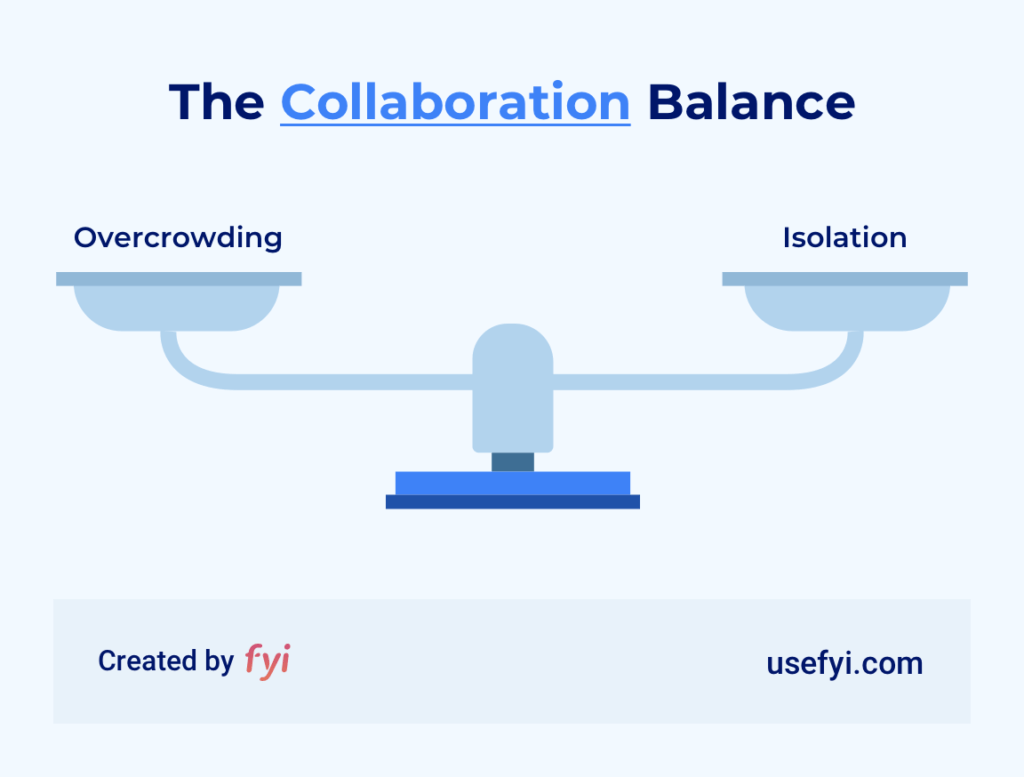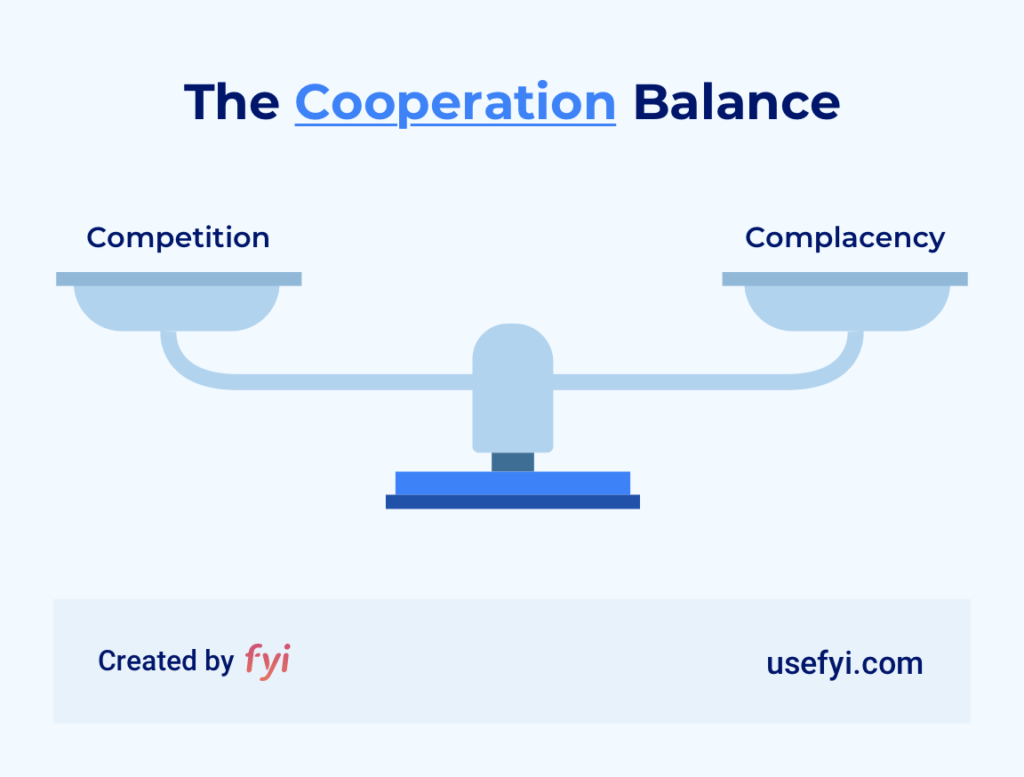Collaboration vs Cooperation and Why it Matters
Collaboration and cooperation don’t mean the same thing.
Both words refer to aspects of working together with others, but there are key differences. Using them interchangeably can result in confusion and obscure team problems.
To build a solid understanding of collaboration vs cooperation, I’ll define both terms, differentiate them, and then talk about why it matters in the workplace.
What’s the difference between Collaboration and Cooperation?
Although the terms are different, they are not opposed like hot and cold. More of one is not less of the other.
Which is to say, it’s possible to be both a collaborative and cooperative person, team or business. Likely, you want to promote both of these processes in the workplace, but they require different sorts of attention.
Let’s take a closer look at both terms individually.
Collaboration
Collaboration is a process of working with others to create something new. The output could be a service, product, or artwork, but collaborative processes always create.
In terms of a workplace process, collaboration is facilitated by the network of connections within and between teams that allow people to work together. These are purposeful connections, oriented toward the continued production and improvement of the company’s offerings.
Collaboration manifests itself in direct connections between individuals, such as co-editing or commenting on shared files, or between teams, like a Scrum of Scrums.
Cooperation
Cooperation is the process of working with others for a common benefit. People assist each other and can expect the same in return.
In the workplace, cooperation is expressed as a readiness to carry out duties and requests for the shared benefit of the team or organization.
People do not necessarily have to work together directly in order to cooperate — they may carry out entirely separate tasks which are nonetheless dependent on the other’s work.
Collaboration vs cooperation: concept clarification
Coming back to consider the difference between these two terms:
- Collaboration describes how individuals and teams work together
- Cooperation describes why individuals and teams work together
In other words, collaboration refers to the networks and relationships that enable groups to create, whereas cooperation refers to the motives and expectations of the people working together.
How this impacts your organization
Understanding how and why your teams work together successfully (or not) is crucial for promoting sustainable growth.
By taking a close look at how collaboration and cooperation play out in your specific workspace, you can encourage constructive behaviors, and steer people away from structures and routines that cause trouble.
Collaboration in the workplace
A company with a thriving culture of collaboration is defined by a workplace process where people are sufficiently connected by the free flow of ideas to accomplish their work, yet not overloaded with communication.

Think of collaboration as the “golden mean” of productive teamwork. People are in direct contact with relevant colleagues, and can reach out to others as needed.
If people are working directly with too many colleagues, however, they’re going to have trouble focusing. Symptoms of overcrowded collaboration include:
- Micromanagement
- Massive meetings with too many ideas
- Confusion amid the deluge of communication.
If, on the other hand, workers and teams don’t have enough connections, they will be isolated from the work and culture of the company. This creates its own set of problems, such as:
- Information silos
- Miscommunication
- Redundancies
It’s not enough to encourage collaboration writ large — you have to be purposeful about the connections you promote between departments and within teams. If people aren’t engaged, for example, information silos can develop even where you have the means of communication established.
Cooperation in the workplace
Cooperation defines a company process where people are working together for mutual benefit. Their work is not aimed at selfish goals, nor do they depend on others to get their work done.

In this case, the extremes are defined by the motives of those involved, rather than by too much or too little cooperation.
On one end is competition, where people are working for their own benefit, rather than that of the team or organization. Competition can be a good thing, though not at the expense of cooperation.
You want people operating at the top of their game, but mutual benefit has to be the ultimate goal. When people are taking actions which help themselves instead of shared purpose, it can develop:
- A toxic company culture that discourages collaboration
- Employee alienation or burnout
- People working at cross purposes
Complacency, on the other end, is expressed by workers that are too dependent on their colleagues. Complacent workers are fine to let others shoulder the burden. This often manifests itself as someone doing the “bare minimum,” which makes their life easier at the expense of their team.
Interdependence is key for cooperation, but people shouldn’t be passing shoddy work up or down the ladder, even if they know someone else will catch it. Beyond frustrating those who are forced to pick up the slack, complacency:
- Discourages professional development
- Stalls product improvement
- Creates unforced errors
What should you focus on? Collaboration or Cooperation?
Here’s the short answer: focus on both.
When it comes to collaboration vs cooperation, you can walk and chew gum at the same time.
In fact, successfully promoting cooperation among individuals and teams is likely to spur collaboration. Why? When people trust that their colleagues are also motivated by the expectation of mutual benefit, they are going to be able to work together much better.
The same holds true for collaboration. By encouraging open communication and collaboration skills, it will be easier for people to respond to each other’s needs, which fosters cooperation.
Here are three steps you can take to encourage both important processes.
1. Identify the roadblocks to collaboration and cooperation
Make a short list of your worst team or departmental breakdowns. You are looking for painful moments, so proceed according to whatever metrics constitute failure at your company: late products, bad service, lost customers, good employees leaving.
I advise getting a small team together as you identify breakdowns. It’s impossible to get a full accounting of the company’s teamwork from a single perspective, and these people can help you roll out and model any future changes you make.
What you are looking for in each of these negative events are impediments to the team’s work that led to problems. If you already carried out a retrospective meeting or postmortem report in the wake of the failed project, it can be very helpful to review those notes.
Other places to look, if you are using project management software, are revision histories and chat logs. This where collaboration and cooperation happens. When you review these spaces, knowing the problematic outcome, it can illuminate where the project went off track.
It may also be a good idea to collect survey information, especially with regards to cooperation, as people’s motives may not be articulated clearly in meeting notes or chat logs. Anonymize the survey if you are worried people won’t be honest.
Be sure to distinguish collaborative and cooperative breakdowns, as they happen for different reasons and require different responses.
For collaborative issues, focus on how each breakdown occurred. Consider:
- Where did information get trapped?
- Where did workflows stall?
- Who wasn’t working together that should have been?
- What would have helped the team reach their goal?
Be attuned to overcrowding and isolation, as instances of either are prime for a renewed approach toward working together. The same person may be subject to too much communication and yet be siloed from crucial information.
For cooperative issues, focus on why each breakdown occurred. Consider:
- What were people’s reasons for not working together constructively?
- Was there an uneven sense of urgency that led to costly delays?
- Were people privileging their work over others?
- Were people counting on others to improve their work?
Uncooperative behavior feeds on itself. When one person refuses to focus on the mutual benefit of the team, others may follow suit, especially if the behavior remains unaddressed. Regardless of how talented someone is, they have to be oriented toward group goals.
The same can happen at the organizational level. When one department is putting its own goals ahead of the well-being of the company, it can cause major problems.
There may also be underlying personality and compatibility issues that damage cooperative behavior. Here, you need to support management in making decisions about people who shouldn’t be working together.
2. Remove roadblocks to collaboration and cooperation
After auditing your short list of breakdowns, you will have identified some of the structural and motivational issues that are getting in the way of your teams’ work. Solving these problems is a two step process.
First, you have to draw up concrete steps people can take to address the lapses in the group’s ability to work together successfully. Some potential fixes include:
- Reorganizing personnel
- Reorganizing lines of communication
- Implementing retrospective tools
- Providing support for collaboration leadership
- Adopting a collaboration tool, or issuing new guidance for the tools you use
Changes should be realistic, as the second part of this step is getting buy-in from the team members who will actually be collaborating and cooperating.
Employees need to be able to see value in these adjustments, and have the support they need to execute. To do this:
- Couch changes you make in language that shows people exactly how the new adjustments will deliver a positive impact.
- Tie your reasoning to the concrete issues you identified in step one. Avoiding these types of mistakes can function as a clear mutually beneficial motive.
- Balance new changes with ongoing work. You may need to budget time and training in order for people to adjust their workflows without unintended consequences.
3. Ensure mutual feedback
Moving forward, you’ll want to track how your changes are taking effect.
Ideally, they will minimize the types of concerns you identified in step one, but you shouldn’t take your eye off collaboration and cooperation. The market changes so fast that systems have to evolve, even when things are going well.
One way to be proactive is to establish channels for feedback where employees can be open about their concerns. These should exist at the team and organizational level, so as to shorten the path information has to travel before it reaches someone who can take action.
You want to make sure that you are giving feedback as well, and encouraging it on the part of others in leadership positions.
Where people are working well together, show appreciation and reward performance. Where problems still exist, a small intervention early could save problems down the road.
The real meaning of collaboration vs cooperation
If you’ve searched for other explanations of collaboration vs cooperation, you’ve probably discovered there is nothing in the way of broad consensus. Conflicting views and definitions abound.
Words get their meaning from the words around them. Green, for example, is a color, but can also signal rookie status or particular stance toward the environment — meaning always depends on the context and how the word is used.
In trying to clarify collaboration and cooperation, what’s important is that you have a cogent, consistent understanding that you can share with confidence.

